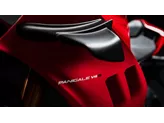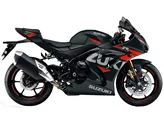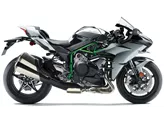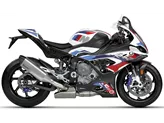Suzuki GSX-R 1000 2009 vs. BMW S 1000 RR 2015

Suzuki GSX-R 1000 2009

BMW S 1000 RR 2015
Vue d’ensemble - Suzuki GSX-R 1000 2009 vs BMW S 1000 RR 2015
The Suzuki GSX-R 1000 2009 and the BMW S 1000 RR 2015 are both supersport motorcycles that offer impressive performance and advanced features. However, there are some notable differences between the two models.
In terms of engine specifications, both motorcycles have inline four-cylinder engines with a displacement of 999cc. The Suzuki GSX-R 1000 has a bore of 74.5mm and a stroke of 57.3mm, while the BMW S 1000 RR has a larger bore of 80mm and a shorter stroke of 49.7mm. This difference in engine design contributes to the BMW's higher power output of 199 HP compared to the Suzuki's 136 HP. However, the Suzuki has a higher torque rating of 116.7 Nm compared to the BMW's 113 Nm.
Both motorcycles feature aluminum frames, but the Suzuki utilizes a twin-spar frame design, while the BMW uses a twin-tube frame. The choice of frame design can affect the handling characteristics of the motorcycle, with the twin-spar frame typically offering better stability and rigidity.

Suzuki GSX-R 1000 2009
In terms of braking technology, both motorcycles have double disc brakes with radial calipers at the front. This technology provides improved braking performance and allows for better control during aggressive riding.
In terms of dimensions and weights, the BMW S 1000 RR has a slightly longer wheelbase of 1425mm compared to the Suzuki's 1405mm. The seat height of the BMW is also slightly higher at 815mm compared to the Suzuki's 810mm. Both motorcycles have the same front and rear tire widths and diameters, as well as a fuel tank capacity of 17.5 liters.
When it comes to strengths, the Suzuki GSX-R 1000 2009 offers improved geometry, a compact engine design, and a relaxed seating position. It also features a system with multiple height adjustments and an anti-hopping clutch, which helps to prevent rear-wheel lock-up during aggressive downshifting.
On the other hand, the BMW S 1000 RR 2015 boasts a superb shift assistant, which allows for quick and smooth gear changes without using the clutch. It also has an incredibly powerful and rev-happy engine, providing exhilarating acceleration. Additionally, the BMW offers a great range of accessories and has a race-ready data logging tool and calibration tool available.

BMW S 1000 RR 2015
In terms of weaknesses, the Suzuki GSX-R 1000 2009 has suboptimal accessibility of the compression adjustment and may feel weak in the lower rev range. It is also not recommended for beginners due to its high performance capabilities.
The BMW S 1000 RR 2015, on the other hand, has a chassis that can quickly reach its limit in the hands of professional riders. This means that it may require more skill and experience to fully exploit its performance capabilities.
Overall, both the Suzuki GSX-R 1000 2009 and the BMW S 1000 RR 2015 are impressive supersport motorcycles with their own unique strengths and weaknesses. The choice between the two ultimately depends on the rider's preferences and level of experience.
Caractéristiques techniques Suzuki GSX-R 1000 2009 par rapport à BMW S 1000 RR 2015
Avantages et inconvénients en comparaison
Avantages et inconvénients en comparaison
Suzuki GSX-R 1000 2009

Malgré une conduite précise et équilibrée et un déploiement de puissance maîtrisé, la GSX-R 1000 reste réservée aux pilotes expérimentés. Suzuki sait qu'un millier doit rester un millier et s'y tient strictement. Espérons qu'elle pourra le faire encore longtemps.
BMW S 1000 RR 2015

Avec des faits concrets, la BMW peut encore marquer des points en 2015. Si vous aimez les performances de pointe, vous devez acheter la BMW. Elle vire en haut avec une puissance incroyable et distancie le reste du peloton dès 200. Les pilotes grands et lourds pourront en profiter encore plus. BMW n'a pas choisi la facilité avec cette machine et a mis sur pied une moto très universelle. Si l'on faisait un test comparatif avec 50 pilotes différents (du rookie au professionnel), la BMW obtiendrait la meilleure moyenne de toutes les motos de 1000 cm3. Le châssis électronique, mais aussi les aides à la conduite, permettent aux professionnels d'aller vite et aux débutants de rouler en toute sécurité. Une recommandation top pour un groupe cible très large. Les pilotes amateurs très rapides ne seront pas satisfaits à 100% par le châssis de série. Ceux qui ne souhaitent pas modifier le châssis devraient plutôt se tourner vers une R1M, une Panigale S ou encore une RSV RF. Quant à ceux qui modifient de toute façon leur moto, ils trouveront avec la S 1000 RR la base la plus puissante et la plus universelle. De manière surprenante, cette machine à la puissance d'ours se comporte également très bien sur les routes de campagne. Dans l'ensemble, cela ressemble à un compromis, mais dans la pratique, ce n'est jamais le cas.
Comparaison des prix Prix moyen du marché Suzuki GSX-R 1000 vs BMW S 1000 RR
There are a few key differences between a Suzuki GSX-R 1000 2009 and a BMW S 1000 RR 2015. In terms of price, the actual average price of a BMW S 1000 RR 2015 is about 82% higher. Compared to BMW S 1000 RR 2015 there are less Suzuki GSX-R 1000 2009 bikes available on the 1000PS.de Marketplace, specifically 6 compared to 8. It takes less time to sell a Suzuki GSX-R 1000 with 64 days compared to 77 days for a BMW S 1000 RR. Since model year 2005 1000PS.de editors have written 71 reviews for the Suzuki GSX-R 1000 and 135 reviews for the BMW S 1000 RR since model year 2010. The first review for the Suzuki GSX-R 1000 was published on 3/3/2004 and now has more than 7,100 views. This compares to more than 4,000 views for the first review on BMW S 1000 RR published on 4/16/2008.


















